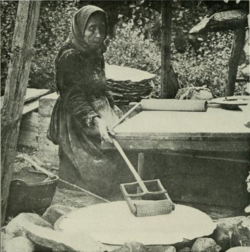Emerstarian cuisine
Emerstarian cuisine (Emerstarian: Emerskemat) originated from the local produce of the country and was enhanced by cooking techniques developed throughout the nineteenth century. There are several traditional Emerstarian dishes which can be considered national dishes; these include underbroden (an open rye bread sandwich with salmon and a variety of vegetables on top), potatensskål (baked potatoes with meatballs, pickled cucumber, and lingonberry jam), and gravleks (salmon cured with salt, sugar, and dill). Many dishes consist of conserved ingredients due to long winters. Fish is generally an ingredient in meals all throughout the nation, but due the large north-to-south expanse to Emerstari, there is variation in the other meats that are served. In the north, there is more venison, rabbit, and poultry whereas in the south, there is more beef and pork. Fruits are not prominent in Emerstarian cuisine, but berries and vegetables like potatos, cabbage, turnips, cucumbers, and recently tomatos (since its introduction to Emerstari in the eighteenth century from Marseile) are. Dairies such as cheese, yogurt, and milk form a smaller part of the Emerstarian diet. In the flatlands, cow milk is generally drank; though elsewhere, goat milk is drank. Alcohol has historically played a role in the Emerstarian diet during winter, and the country is known for its Haller and Malmø beers abroad.
While grocery stores are present within Emerstari, most are located only within big cities; Emerstarians usually grow their own food and raise their own livestock or buy produce and meat directly from a tradesman such as a dairy farmer or a butcher.
History
The winters of Emerstari placed importance on preserving food, and thus, fish, which were easily attainable by the general population, were salted and cured; salt was a major trade item of Emerstari throughout the middle ages. Cabbage too was preserved as surgrønnsaks, cucumbers as pickled cucumbers, apples as apple sauce, and berries, used as an important form of vitamin C with apples, as jam. Lingonberry jam is still a favorite dish among many Emerstarians, traditionally being used as an Emerstarian way to add freshness to steaks, stews, and breads. Turnips, which would survive through the winters, were also cornerstones of an Emerstarian diet, but in the seventeenth century, they came into competition with the potato. Today still, but then more so, a distinct lack of spices made Emerstarian meals rather bland by other national standards.
Traditional main meals
Breakfast (Mornsmat)
A traditional Emerstarian breakfast, which historically was not eaten until ten o'clock or so, consists of eggs in various forms, breads in various forms and oats as oatmeal, jams, and sliced meats complimented by milk. Light breakfasts may consist solely of crisp breads, like hardtskebrod, and tea.
Lunch (Middegsmat)
Lunch is usually a small meal in Emerstari, if it is eaten at all, as the Church of Emerstari has endorsed midday-fasting. It may consist of open sandwiches and dairy.
Dinner (Nichtsmat)
Emerstarian dinners, which have emphasis placed on them due to the absence of a lunch in midday-fasting, include one or two courses. Often, the first course is the main item, which may be cooked meat, and the second course is made up of smaller items, like vegetables and breads. In the modern-day, foreign-inspired meals like pizza and pasta have become popular as well. Desserts, if they are served, are likely to be baked goods, ice cream, or fruits.
Traditional feasts
Christmas Eve dinner
The dinner served on the night of Christmas Eve, known as Kristusdegbord, is traditionally a three course dinner:
- The first courise is typically fish, especially herring and salmon or even eel, with vegetables such as turnips or potatoes. This is accompanied by snaps, travin, or akvavit.
- The second course consists of more meats, including the main Christmas venison or ham, various types of cheese, pickled cucumber, and crisp breads.
- The third course includes warm dishes like meatballs, sausages, pork ribs, and potato casseroles.
- A fourth course, dessert, may be served with kannelbrod (cinnamon bread), appelkakke (apple pie), ostkakke (cheese cake), or risgrot (rice pudding).
Easter
The dinner served on the night of Easter is a simpler dinner than that of Christmas. It is distinguished by the prominent precense of alcohol. Easter dinner is traditionally two courses, not accounting for dessert:
- The first course is known as keldskebord (cold table), and it is consistent of pickled herring, turnips and cabbage, and various cold cuts. Påskeskebryggeål (Easter brew beer) is served with this dish.
- The second course is known as varmskebord (warm table). Typical dishes present are rabbit in the north or mutton in the south, eggs, cheese, and berries.
Eating out

Emerstari has many fine dining restaurants, not only in large cities, but also throughout the countryside. There are many inns in Emerstari which provide lodging as well as traditional meals and drinks. There are numerous royally priveleged inns which also serve as museums of sorts. There are also many restaurants that specialize in foreign cuisine, particularly pizzarias, which can be found in most every town in the country.
Fastfood
Fastfood establishments are almost a rarity in Emerstari and are mostly just in large cities. The first fastfood restaurant in Emerstari appeared in 1982 in Yoerk and was part of a chicken-serving chain which originated in Roele.



